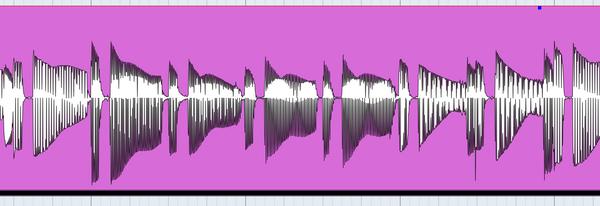Hey Guys!
This is an acoustic guitar recorded line in with the built in pickup. Why do the transients point upwards but not really down? It's not using the whole space. What does this mean?
Comments
One answer to the original question is that waveforms can look l
One answer to the original question is that waveforms can look like that - it's not your eyes that respond to the sound. I'm assuming that the recorded sound is OK, and that you are tracking this down out of interest and not trying to diagnose a sonic problem.
Is this recorded from a magnetic pickup on the guitar rather than an internal guitar mic or an acoustic pickup? A magnetic pickup is a velocity transducer and captures a representation of the speed at which the string is moving and not the position of the string. Guitar strings move rapidly on the first release after the pick hits and then, depending on the players hand action, can damp relatively quickly, unless they are open (unstopped).
The first check here is to see what happens to the waveform on an up-pick rather than a down-pick. If the higher peaks of the waveform are now in the negative half, then there is the simple answer. If the waveform still looks similar, then make sure you are going directly from the guitar pickup into a pre-amp DI input and not through a pedal or some other effect unit. If the waveform still looks the same with a clean chain from pickup to DI, check that you do not have any compression or other amplitude-altering effect set in your DAW.
Thanks for stopping by Boswell. :) You are completely right, I
Thanks for stopping by Boswell. :)
You are completely right, I am tracking this down out of interest... No pun intended. ;)
The pickup was not magnetic, but now I am having the same problem except negative instead of positive with my bass guitar, which is of course a magnetic pickup. Check out this screenshot:
I am missing headroom because of this, right? That is the real problem that I am trying to solve here. I could have a louder signal if the signal was going as far positive as negative. And if I run a compressor on this, it will compress the positive and negative waves, right? That's no good. This screenshot was recorded going into a DI box with the filter turned on (I don't actually know what the filter does, but it must be good, right? Lol). I tried the up-picking and down-picking thing, but it doesn't seem to make a difference. And I am pretty sure I don't have any compression or effects on the way in on my DAW that could effect the recorded wave form. :/
I don't have any better explanation than Boswell, but I do want
I don't have any better explanation than Boswell, but I do want to comment on your "I'm missing headroom because of this," "I'm not filling the whole space." This is bad mindset to have for digital recording. It makes sense if you are recording to analog tape (with a tiny signal to noise ratio compared to digital and a musical way of dealing with clipping), but not to 24bits of digital media (with huge signal to noise ratio and harsh clipping.) I try to maintain a consistent level of RMS (average) level on all of my tracks. That means that if my drums are tracking at -6 dBFS peak, then bass (which has 6-10 dB smaller dynamic range) should track with peaks at something like -12 dBFS peak level. One of the biggest beginner mistakes in digital recording is tracking too loud. You may not clip on the original track, but you will clip in the plugin or clip in the mix.
BobRogers, post: 391628 wrote: One of the biggest beginner mista
BobRogers, post: 391628 wrote: One of the biggest beginner mistakes in digital recording is tracking too loud.
Wow, that's definitely a mistake I am making then, and I'm glad you pointed it out. I thought you should always record as loud as possible to get as much dynamic range as possible. I always try to aim for as loud as possible without peaking.
How do you measure the dBFS level? I know that half way between peak and silence in -6dBFS, but that's the only reference point I have.
I found another spot, this one is worse than all the rest. This
I found another spot, this one is worse than all the rest. This is the same acoustic guitar as the first screenshot, tracking much higher positively than negatively as usual, but in one spot it peaks negatively out of nowhere.
Now I know for sure that this would kill the headroom. :/










Someone will answer you. Just be patient. I don't know the answe
Someone will answer you. Just be patient. I don't know the answer to this. It may be a phase thing. It may be a view setting in Cubase. I don't know. I'm sure someone here will though. Boswell or dvdhawk. Some of these guys are very knowledgeable. I wish I could count myself among them but they are leagues beyond my ability.